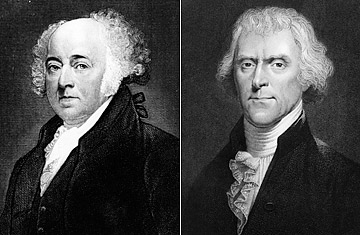
L. to R.: John Adams; Thomas Jefferson
United States, 1800
Thomas Jefferson vs. Aaron Burr
The controversial 1800 election was just like Bush v. Gore — only worse, because the Constitution was only 11 years old and unproven when the crisis hit. In the early Republic, electoral-college delegates voted for two candidates; the top finisher became President and the runner up was named V.P. When the 1800 election ended in a tie, however, that rule began to look ill-conceived. President John Adams, running with Charles Pinckney, was facing off with Vice President Thomas Jefferson, who had teamed up with Aaron Burr. The Federalists, backing Adams, remembered to give their Presidential candidate one more vote than their desired Vice President, throwing a single nod to John Jay, who was not even running. The Democratic-Republicans, however, forgot to do the same for Jefferson. Both Jefferson and Burr wound up with 73 electoral votes to Adams' 65 and Pinckney's 64. The running mates were now rivals, and tie-breaking duties fell to the House of Representatives.
The voting dragged on for seven days and 36 ballots. Alexander Hamilton, who disliked Jefferson's politics but loathed Burr intensely, was a key player in the Vice President's eventual victory. (As history shows, Burr got Hamilton back eventually.) In 1804 the 12th amendment was passed, requiring that electors vote specifically for a President and Vice President.